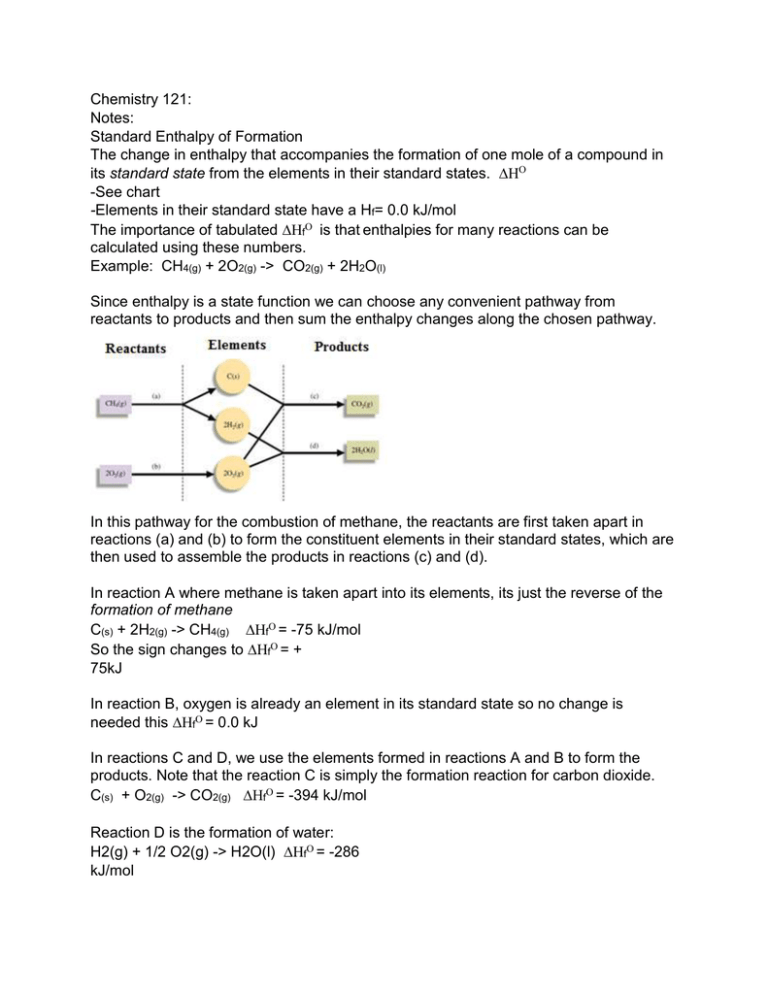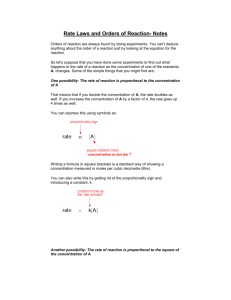Standard Enthalpy of Formation
advertisement

Chemistry 121: Notes: Standard Enthalpy of Formation The change in enthalpy that accompanies the formation of one mole of a compound in its standard state from the elements in their standard states. -See chart -Elements in their standard state have a Hf= 0.0 kJ/mol The importance of tabulated fis that enthalpies for many reactions can be calculated using these numbers. Example: CH4(g) + 2O2(g) -> CO2(g) + 2H2O(l) Since enthalpy is a state function we can choose any convenient pathway from reactants to products and then sum the enthalpy changes along the chosen pathway. In this pathway for the combustion of methane, the reactants are first taken apart in reactions (a) and (b) to form the constituent elements in their standard states, which are then used to assemble the products in reactions (c) and (d). In reaction A where methane is taken apart into its elements, its just the reverse of the formation of methane C(s) + 2H2(g) -> CH4(g) f= -75 kJ/mol So the sign changes to f= + 75kJ In reaction B, oxygen is already an element in its standard state so no change is needed this f= 0.0 kJ In reactions C and D, we use the elements formed in reactions A and B to form the products. Note that the reaction C is simply the formation reaction for carbon dioxide. C(s) + O2(g) -> CO2(g) f= -394 kJ/mol Reaction D is the formation of water: H2(g) + 1/2 O2(g) -> H2O(l) f= -286 kJ/mol However, since 2 moles are required in the balanced equation, f= -286 kJ/mol x 2= -572 kJ Having completed the pathway from reactants to products, we can calculate the rxn rxn = A +B +C +D = +75kJ + 0kJ + (-394kJ) + (-572kJ) = -891kJ The enthalpy change for a given reaction can be calculated by subtracting the enthalpies of formation of the reactants from the enthalpies of formation of the productsremembering to multiply the enthalpies of formation by the integers required by the balanced equation. A chemical Equation can be express as a sum of formation reactions. ∆Horeaction= ∑nHOf(Products)- ∑nHOf(reactants) Steps: 1. Write the balanced equation for the reaction 2. Obtain the molar heats of formation for all reactants and products 3. Multiply the molar heat of formation by the molar coefficient for each reactant and product. H=nHf 4. Sum the heats of formation for the reactants and products separately. 5. Calculate the molar heat of reaction for the substance specified. ∆H/#moles (n) Example: Calculate the Hrxn CO for the reaction of carbon monoxide gas with oxygen to form carbon dioxide gas. Step 1:Write the balanced equation for the reaction 2CO(g) + O2(g) --> 2CO2(g) Step 2: Obtain the molar heats of formation for all reactants and products Hf CO(g)= -110.5kJ/mol Hf O2(g) = 0 kJ/mol Hf CO2(g) = -393.5 kJ/mol Step 3: Multiply the molar heat of formation by the molar coefficient for each reactant and product. H=nHf nHf 2mol x -110.5kJ/mol kJ/mol=-221.0 kJ 1mol x 0 kJ/mol= kJ 2mol x -393.5 kJ/mol=-786.0 kJ Step 4: Sum the heats of formation for the reactants and products separately. Reactant sum: Product sum: -221.0kJ -786.0 kJ Step 5: Calculate the molar heat of reaction for the substance specified. ∆H/#moles (n) ∆Horeaction= ∑nHOf(Products)- ∑nHOf(reactants) = -786.0 - (-221.0kJ) = -565.0 kJ / 2mol HoCO =-282.5 kJ/mol In respiration, glucose is oxidized by oxygen to produce carbon dioxide gas, liquid water, and energy. What is the energy released when 18.0g of glucose is consumed assuming products are at standard conditions?





